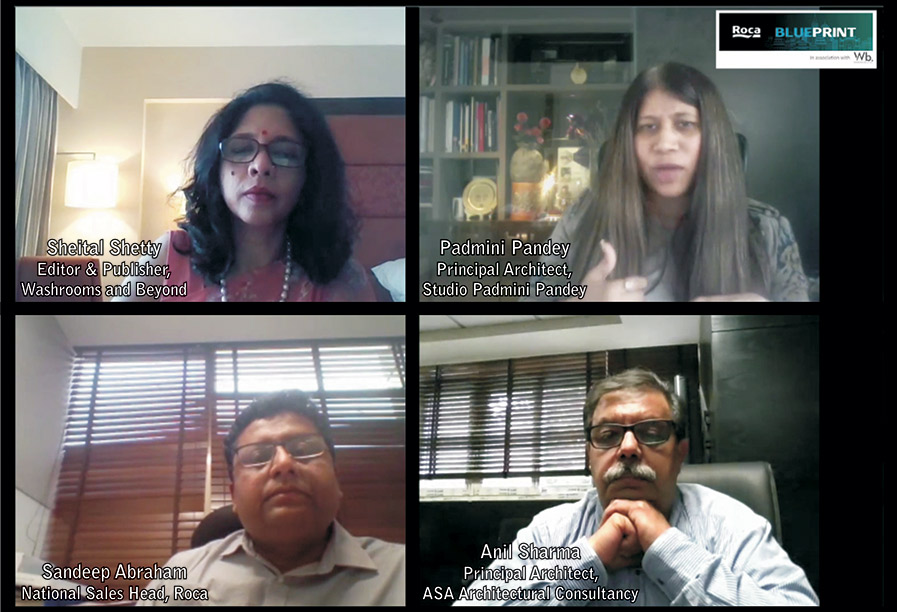Bathrooms of the future:
Is smart tech the way ahead?
The panellists, at Roca Blueprint in association with Wb., discuss the factors impacting the design of bathrooms, integration of smart fixtures in washrooms and whether the market is ready for such solutions.
Technology is increasingly becoming a part of our daily lives. And, the Covid-19 pandemic has further accelerated the deep integration of technology. Smart home as a trend is really catching on in the upmarket housing segment.
“The usage of smart devices like Bluetooth speakers, smart showers, connected dispensers, occupancy trackers and the likes are on the surge. Interestingly, even the mid-segment is aspiring to upgrade to smart technology especially in the current situation,” opines Sheital Shetty, Editor and Publisher, Washrooms and Beyond.
Changing user lifestyle
Talking about changing user lifestyle and how that has impacted the increasing demand of smart technologies, Anil Sharma, Principal Architect, ASA Architectural Consultancy adds, “Post-Covid, there are going to be changes in the way we design spaces. For example, house will become more luxurious as people spend more time in home. During this past one year, we have realised the true potential of technology and from something we aspire it has transitioned to become necessity.”
He further adds that in the Indian hospitality industry, use of technology in the bathroom space was very limited but now there will be a demand for integration of smart technologies in the bathrooms in hotels as well.
Padmini Pandey, Principal Architect, Studio Padmini Pandey adds, “I think the Covid-19 induced pandemic has presented with an opportunity to integrate technology with every aspect of life which has become like a mini renaissance across the world. Even the older generation and those who are not tech-savvy has become more open towards technology.”

Sheital Shetty
Editor & Publisher, Washrooms and Beyond
“The usage of smart devices like Bluetooth speakers, smart showers, connected dispensers, occupancy trackers and the likes are on the surge. Interestingly, even the mid-segment is aspiring to upgrade to smart technology especially in the current situation.”
Value added service driven innovation
Shetty adds that increasing push for value added services and convenience is pushing the bathroom towards smart technologies. “It has gone beyond the primary function of the product. For example, in shower it is related to lighting, music, massage. In Wcs, it is self-cleaning, temperature adjustment, controlling via remote or smartphone etc.”
Pandey agrees, “Bathrooms are about designing an experience. The rejuvenation in the washroom space is going beyond physical freshness and aims to provide mental and emotional relaxation. Given the space constraint in metros, the value addition can only come through integration of technology – be it the addition of music, colour changing or gadgets that interacts with the user. It is about doing more with less.”
Talking about the evolutions of washrooms in hotels, Sharma adds, “The penchant to improve the user experience and environmental concern led to several design changes; for example, the concept of brining in natural light, focusing on energy efficiency and water conservation. The number of fixtures is coming down and bathtubs are becoming a passé now.”
The smart bathroom
In the luxury segment, smart water closet is a popular choice. A smart toilet essentially is an advanced toilet using built-in smart technology, or technology capable of interacting and connecting with the user. Smart toilets come with a wide range of popular features. “The majority of smart toilets can warm the toilet seat to fit user preferences. The automatic lid enables the toilet to open or close the lid automatically, leaving the experience completely touch-free. Smart toilet comes with a bidet which allows the user to adjust the spray pressure and water temperature,” shares Pandey.

Padmini Pandey
Principal Architect,
Studio Padmini Pandey
“I was very intrigued by a shower system that is totally automated and could be controlled from a smartphone. It can turn on the steam, fill up the bathtub, preheat water, monitor water usage and even control lighting in the room and can even be activated remotely. “
Another category where technology has made inroads is the shower. Packed with sophisticated technologies like water saving, spray control and music player etc, the modern day showers are meant for providing experiences like bathing in an actual waterfall or rain that leaves the user feeling elated and refreshed. While cascade showers give a waterfall experience, rain showerheads give the complete experience of rains. High tech showers today include steam jets, aromatherapy jets and have digital interface panels handing over the control of water, light, sound and steam to the users.
Sharma is a bit conservative about the prospects of smart gadgets in the hospitality industry. “Unlike residential segment, the hotels have a vast set of clientele and many of them might not be comfortable with using smart gadgets. It is only in the suites of the luxury hotels where such smart bathrooms will work. But technology that will save water and energy and help in maintenance is something the hospitality industry looks forward to.”
Internet of Things (IoT) in action
Keeping pace with changing lifestyle and increasing adoption of automation in every phase of life, even the washroom fixtures are going digital. How the user interacts with the fixture is also changing with increasing use of voice assistant like Amazon Alexa or google Assistant and IoT is at the forefront of this revolution. The simplification of these nuanced technologies by use of app and remote has meant that even those non tech savvy users can benefit from the use of products like Bluetooth speakers, smart showers, connected dispensers, occupancy trackers and much more.
Sharing about a smart shower that impressed Pandey, she shared, “The one I was very intrigued by was a shower system that is totally automated and could be controlled from a smart phone. It can turn on the steam, fill up the bathtub, preheat water, monitor water usage and even control lighting in the room. In fact, the user can activate it remotely so that by the time he/she enters the bathroom, everything is ready and there will be no waiting time.”

Anil Sharma
Principal Architect,
ASA Architectural Consultancy
The cost attached to smart fixtures is a factor that prevents widespread adoption. The longevity and maintenance will be an issue where the water source is not of quality. That makes people reluctant to go for expensive fixtures. However, in the luxury segment there will be many takers for smart fixtures.”
While the aspirations come from the end users and the designers act like facilitator incorporating the technology in the bathroom, it is the manufacturers who supply the products that makes the space smarter. And to this direction, Roca is introducing Roca Protect – a smart bathroom solution system that offers real time monitoring, management and maintenance for any kind of bathroom.
Talking about this, Sandeep Abraham, Head – Sales, Roca Bathroom Products Pvt. Ltd. adds, “Roca Protect is an app-based technology that we introduced in Europe last year and have been implemented in more than 100 restrooms. This is probably the pinnacle of smart bathroom technology. Though we are yet to launch this in India, we have seen a surge in demand for smart bathroom solutions like smart toilets, sensor faucets and other touchless products in
the last 6-7 months – especially so in the high-end products category. ”
Is smart tech the way ahead?
While there are a lot of things going for the smart fixtures, it’s not completely rosy. It has a fair share of challenges for these technologies to be widely accepted in the Indian market.
For example, sometimes use of lot of gadgets leads to a cumbersome experience for those non tech-savvy users. “Technology is meant for comfort and ease; it’s not supposed to create clutter and confusion. It’s the user’s reluctance or the inertia towards the technology that is the root of the problem. Many of the issues in this front will be taken care of once we start to embrace technology,” opines Sharma.
Pandey feels that sometimes the problem creeps in because of the way the technology is presented. “If the user interface is complex for an average mind, it will create confusion. Making things easy and simpler is not an easy task and that is the challenge facing the manufacturers.”

Sandeep Abraham
Head – Sales, Roca Bathroom Products Pvt. Ltd.
“In the post-Covid era, people with disposable income even in the smaller towns are buying these smart fixtures and we have seen a surge in demand from these areas in the last 5-6 months. We expect this trend to gain further momentum in the next 2-3 years.”
Talking about the acceptability of smart bathroom tech in the Indian market, Sharma adds that the vast majority of the market is still driven by value. “The cost attached to smart fixtures is a factor that prevents widespread adoption. The quality of water is another issue which the user has no control on. The longevity and maintenance will be an issue where the water source is not of quality – for example in places like Delhi NCR. That makes people reluctant to go for expensive fixtures. So, infrastructural improvement in those areas is needed before we look at widespread adoption of smart fixtures.” He, however, feels that in the luxury segment, there will be a lot of takers for the smart fixtures.
Pandey is upbeat about the prospect of these smart fixtures in the luxury segment. “India has a demographic advantage in this aspect as majority of the population is very young who are tech-savvy. However, the success of these technologically advanced products will also depend upon the simplification of the UI and reliability of after sales service.”
Abraham adds, “In terms of market penetration, may be the top 30% which is the luxury segment buys these kinds of smart fixtures. However, of late, there are many surprises in the post-Covid era. For example, we had a client from Parbhani – a tier-III or IV city of Maharashtra, buying a Bluetooth vanity with LED mirror and smart toilet. So, people with disposable income even in those smaller towns are buying these smart fixtures and we have seen a surge in demand from these areas in the last 5-6 months. And, we expect the trend to gain further momentum in the next 2-3 years.”
[Inputs from 1st edition of Roca Blueprint in association with Washrooms and Beyond held digitally on February 19, 2021.]
Tags: Anil Sharma, Hi-Tech Bathroom, Padmini Pandey, Roca, Roca Blueprint, Sandeep Abraham, Sheital Shetty, Smart Bathroom



